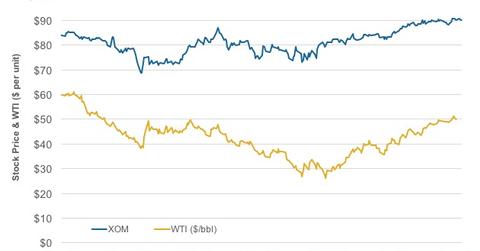What’s the Correlation between XOM’s Stock and Crude Oil?
Integrated energy companies such as ExxonMobil (XOM) are affected by volatility in crude oil prices. To what degree? This varies from company to company.
July 4 2016, Updated 2:04 a.m. ET

What is a correlation coefficient?
In this series, we’ve discussed ExxonMobil’s (XOM) plans to exit the Bass Strait. We’ve also analyzed its stock movements, business segments, leverage, cash flows, and valuations. In this part, we’ll test the correlation between XOM’s and crude oil’s price.
The correlation coefficient shows the relationship between two variables. A correlation coefficient value of 0 to 1 shows a positive correlation, 0 states no correlation, and -1 to 0 shows an inverse correlation. We’ve considered the past 12 months worth of price histories for XOM and WTI (West Texas Intermediate).
XOM’s stock and crude oil price
Integrated energy companies such as ExxonMobil are affected by volatility in crude oil prices. To what degree? This varies from company to company. XOM’s correlation coefficient with WTI stands at 0.55. This means that on average, 55% of the movements in XOM’s stock price can be explained by changes in WTI prices.
ExxonMobil’s peer YPF (YPF) shows a similar correlation at 0.55. However, other integrated energy players PetroChina (PTR) and Eni (E) show higher positive correlations with WTI at 0.58 and 0.63, respectively.
On the other hand, standalone downstream companies show feeble correlations with crude oil. A case in point is Valero (VLO), a refiner with a 0.17 correlation with WTI.
If you’re looking for exposure to the integrated energy sector, you can consider the iShares North American Natural Resources ETF (IGE). The ETF has ~21% exposure to the sector.
